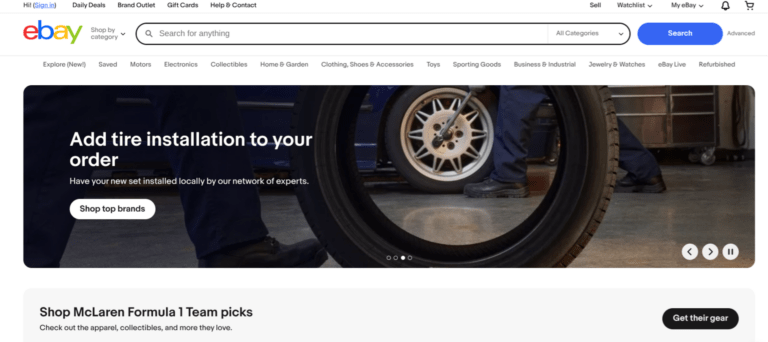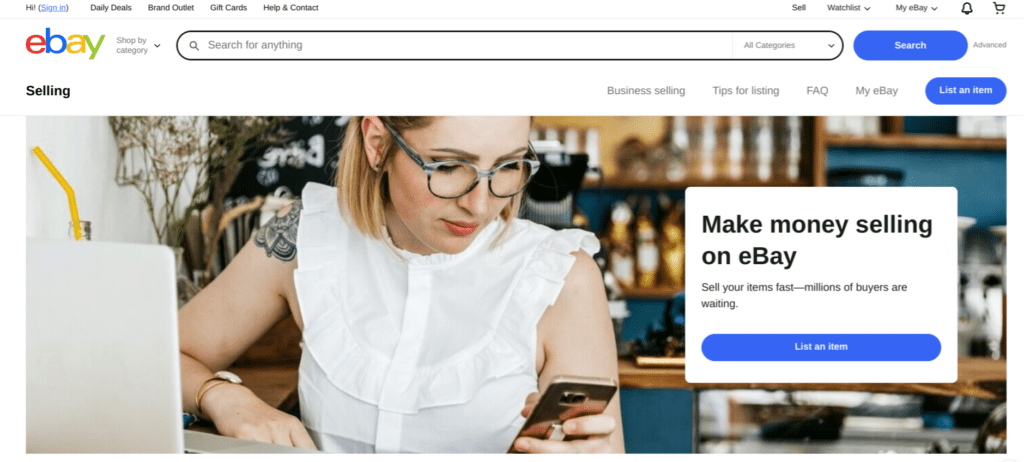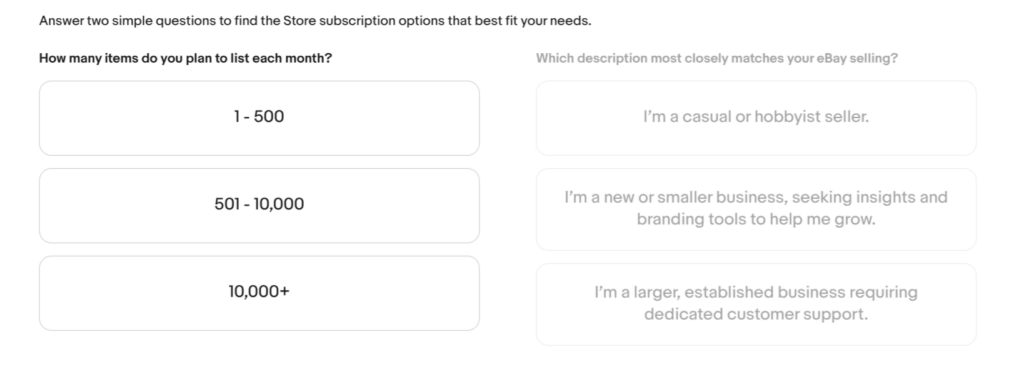A Step-by-Step Guide to Setting Up Your Business Account on eBay

Looking to take your business to new heights? eBay is the perfect platform to showcase your products or services to a global customer base. However, setting up your business account on eBay can seem like a daunting task. But worry not, because we’ve got you covered!
In this comprehensive guide, we will take you through the step-by-step process of setting up your business account on eBay, ensuring that you have all the tools and knowledge to unlock success. From creating your account and choosing the right business category to optimising your listings for maximum visibility, we will provide you with insider tips and tricks to help you stand out in the crowded marketplace.
With over 180 million active buyers on eBay, the potential for growth is enormous. Whether you’re a small business owner, a freelancer, or an established entrepreneur, this guide is designed to help you navigate the intricacies of eBay’s platform and maximize your chances of success.
Follow our expert advice and start harnessing the full potential of eBay to grow your business today. Success is just a few clicks away!
Benefits of Setting Up a Business Account on eBay

When considering a platform for selling products online, eBay stands out due to its vast reach and established reputation. One of the primary benefits of setting up a business account on eBay is access to a massive audience. With over 180 million active buyers worldwide, eBay provides a marketplace where sellers can connect with customers from various demographics and locations. This extensive reach can significantly enhance visibility and sales potential for your products, making it easier to grow your business beyond local limitations.
In addition to a broad customer base, eBay’s business accounts offer various tools and features tailored specifically for sellers. These include advanced reporting and analytics that help track sales, monitor inventory levels, and analyze customer behavior. Such insights enable you to make informed decisions regarding pricing strategies, inventory management, and marketing efforts. Moreover, eBay provides promotional tools that allow sellers to create targeted advertisements and special offers, helping you to attract more buyers and boost your sales volume.
Another advantage of having a business account is the credibility it brings. Buyers are often more inclined to trust established businesses over individual sellers. By registering as a business, you can enhance your professional image and build trust with potential customers. eBay also provides seller protections and resources specifically designed for businesses, ensuring that you have the support and tools necessary to resolve any issues that may arise during the selling process. This peace of mind can be invaluable for new entrepreneurs navigating the complexities of online selling.
Understanding the Requirements and Eligibility for a Business Account

Before diving into the setup of your eBay business account, it’s crucial to understand the eligibility criteria and requirements. eBay defines a business account as an account intended for selling products in bulk or as part of a commercial enterprise. This means that if you plan to sell items regularly or operate a business, you should consider registering as a business seller. To be eligible, you’ll need to provide some basic information, including your business name and contact details, which can be verified through official documentation.
Besides the initial information, eBay may require you to provide a valid credit card, bank account details, and tax identification numbers. These details are necessary for payment processing and tax reporting purposes. Depending on your location and the nature of your business, eBay may also ask for additional documentation to verify your business status. This verification process is designed to create a secure marketplace for buyers and sellers alike, ensuring that all transactions are legitimate and trustworthy.
It’s also essential to review eBay’s policies and guidelines regarding selling practices. Familiarizing yourself with these rules can save you from potential pitfalls and ensure compliance with eBay’s standards. From understanding listing requirements and prohibited items to adhering to payment and shipping policies, being well-informed will help you operate your business smoothly and avoid unnecessary complications down the line.
Creating an eBay Business Account

To kick off your journey, the first step is to create your eBay business account. Start by visiting the eBay homepage and clicking on the “Register” button. You’ll be presented with options to create either a personal or business account. Select “business account” and fill in the required fields, including your business name, email address, and a password. It’s advisable to use a business email to maintain professionalism and facilitate communication.
Once you’ve completed the registration form, eBay will send a verification email to the address you provided. Click on the link in the email to verify your account. After verifying your email, log back into eBay and proceed to fill out additional information about your business. This may include your business type (e.g., sole proprietorship, corporation), contact information, and any applicable business licenses or registrations.
Finally, review and agree to eBay’s user agreements and policies before clicking the “Create Account” button. Your account is now set up! This initial step lays the foundation for your business presence on eBay, and it’s crucial to ensure that all information entered is accurate and up to date, as this will affect your selling experience and customer interactions.
Setting Up Your Seller Profile and Business Information
With your account created, the next step is to set up your seller profile and business information. Your seller profile is a critical aspect of your eBay presence, as it tells potential buyers who you are and what they can expect from your business. Start by navigating to your account settings and selecting the option to edit your seller profile. Here, you can add a business logo, a compelling business description, and your return policy.
Your business description should highlight what your business offers, your unique selling points, and any relevant experience or credentials. This is your opportunity to establish credibility and connect with potential customers. Make sure to use clear, professional language that reflects your brand identity. Additionally, including high-quality images or graphics can enhance your profile and make it more visually appealing.
It’s also essential to provide accurate contact information, including a customer service email and phone number. This transparency builds trust with buyers and encourages them to reach out with questions or concerns. Ensure that your policies regarding shipping, returns, and customer service are clearly outlined in your profile. The more transparent you are about your business practices, the more likely you are to foster positive relationships with your customers.
Choosing the Right eBay Store Subscription

eBay offers various store subscription plans, each tailored to different selling needs and volumes. Selecting the right plan is crucial for optimizing your eBay selling experience and managing costs effectively. The basic store subscription is suitable for smaller businesses or those just starting, offering essential features at a lower cost. As your business grows, you might consider upgrading to a premium or anchor store, which provides additional benefits such as increased listing limits, lower final value fees, and enhanced marketing tools.
Before choosing a subscription, evaluate your selling goals and the types of products you intend to sell. If you anticipate listing a large number of items or selling high-value products, a premium or anchor store could provide significant savings in fees and access to advanced selling features. Additionally, eBay offers a 30-day free trial for new store subscriptions, allowing you to explore the benefits without immediate financial commitment.
It’s also worth considering the promotional opportunities that come with store subscriptions. Higher-tier plans often include marketing tools such as promotional listings, which can help boost visibility for your products. These marketing resources can significantly enhance your sales potential, making it easier to attract buyers and increase your revenue. Take the time to assess your business needs and select the plan that best aligns with your goals for growth and profitability.
Listing Your Products Effectively on eBay
Now that your account is set up and your store subscription is chosen, it’s time to focus on listing your products effectively on eBay. Start by conducting thorough research on similar items to understand pricing, descriptions, and keywords that resonate with potential buyers. This research will help you craft compelling listings that stand out in search results and attract attention.
When creating your listings, pay close attention to the title and description. Use clear, descriptive language that includes relevant keywords, making it easier for buyers to find your products. Ensure that your title is informative yet concise, highlighting key features and benefits. In the description, provide detailed information about the product, including specifications, condition, and any additional features. The more informative your listing, the better the chances of converting views into sales.
Additionally, high-quality images are essential for effective listings. Take clear, well-lit photographs from multiple angles, showcasing the product in detail. eBay allows multiple images per listing, so utilize this feature to provide a comprehensive view of your items. A visually appealing listing can significantly enhance buyer interest and increase the likelihood of a sale. Don’t forget to set competitive prices based on your research, factoring in shipping costs and eBay fees to ensure profitability.
Managing Your eBay Business Account and Orders
Once your products are listed, effective management of your eBay business account and orders becomes paramount for success. Start by monitoring your sales regularly through the eBay dashboard, which provides valuable insights into your performance, including sales trends, customer feedback, and order status. Staying organized is crucial, especially as your business scales, so consider using eBay’s tools or third-party software to help manage inventory and track orders efficiently.
Communication with customers is another critical aspect of managing your eBay business. Promptly respond to inquiries and provide updates on order statuses. Good customer service can lead to positive feedback and repeat business, which are vital for maintaining a good seller rating on eBay. Set realistic processing and shipping times and ensure that you meet or exceed these expectations to enhance customer satisfaction.
Additionally, regularly review your listings and performance metrics to identify areas for improvement. Adjust your pricing strategies, optimize listings based on customer feedback, and experiment with promotional strategies to boost sales. Embrace the flexibility of eBay’s platform to adapt to market trends and customer preferences, ensuring that your business remains competitive and profitable over time.
Tips for Optimising Your eBay Listings and Increasing Sales
To truly unlock success on eBay, optimizing your listings is essential. Start by leveraging eBay’s Best Offer feature, which allows buyers to negotiate prices. This interactive approach can lead to higher sales conversion rates as it engages customers in the purchasing process. Additionally, consider offering free shipping; eBay often favors listings that include free shipping in search results, making them more attractive to buyers.
Incorporating promotions into your selling strategy can also yield positive results. Utilize eBay’s promotional tools to create sales events, volume discounts, or coupons for returning customers. Such incentives encourage purchases and can help clear out excess inventory. Regularly updating your listings with new promotions keeps your shop fresh and can draw in repeat shoppers looking for deals.
Lastly, pay attention to your seller metrics and feedback ratings, as these play a significant role in your visibility on the platform. Aim for high ratings by providing excellent customer service and ensuring that products are as described. Respond to all feedback, both positive and negative, as this demonstrates your commitment to customer satisfaction. Continuous improvement in these areas will enhance your reputation and increase your chances of success on eBay.
Conclusion and Next Steps
Setting up your business account on eBay is just the beginning of your journey to online selling success. By understanding the benefits of a business account and following the steps outlined in this guide, you are well-equipped to navigate the eBay marketplace. Remember to continually refine your strategies, adapt to market trends, and prioritize customer satisfaction to drive sales growth.
As you embark on this exciting venture, consider joining eBay seller communities or forums to connect with other sellers. These platforms can provide support, share insights, and offer valuable tips for enhancing your eBay experience. Additionally, keep an eye on eBay’s updates and feature releases, as the platform regularly evolves to meet the needs of sellers and buyers.
With determination, creativity, and a willingness to learn, you can unlock the full potential of eBay to grow your business. Start implementing the strategies discussed in this guide, and watch your eBay venture flourish as you capitalize on the incredible opportunities the platform has to offer.
This is why your ecommerce business needs OnePatch
OnePatch offers businesses an easy to use ecommerce solution for multi channel selling
Integrations
Take a 7 day trial
- Our Onboarding team will contact you to assist in setting up your free trial.
- HiddenAfter your 14-day trial your account will still be able to access your free Ecommerce dashboard.
- This field is for validation purposes and should be left unchanged.

